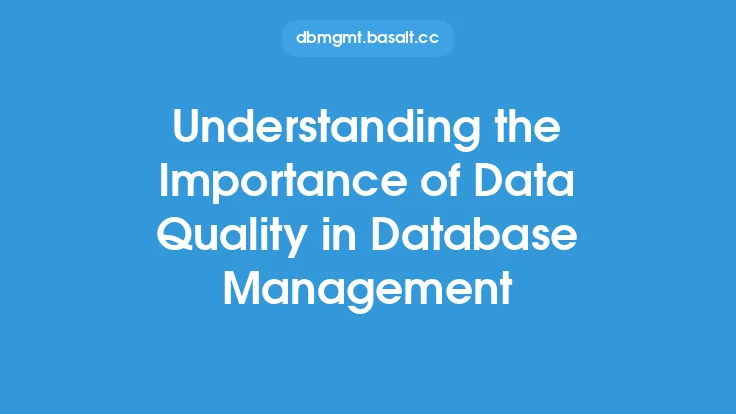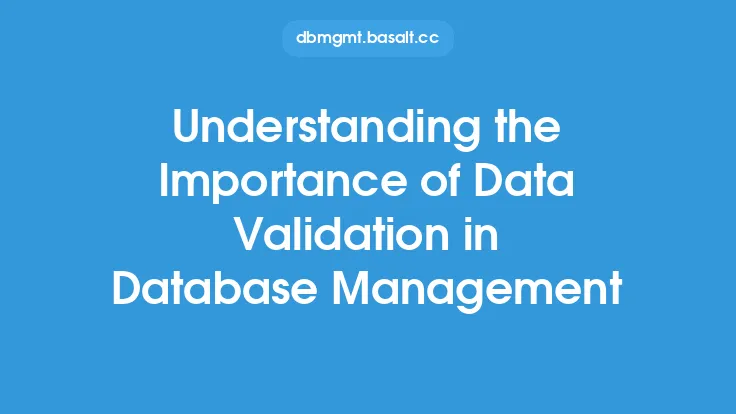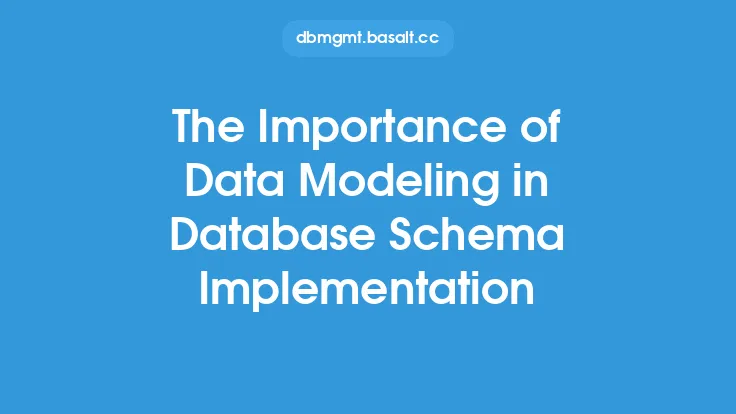When designing a database, one of the most critical aspects to consider is the formatting of the data. Consistent data formatting is essential to ensure that the data is stored, retrieved, and manipulated efficiently and effectively. Inconsistent data formatting can lead to a range of problems, including data errors, inconsistencies, and difficulties in data analysis and reporting. In this article, we will explore the importance of consistent data formatting in database design and discuss the benefits and best practices for achieving consistent data formatting.
Introduction to Data Formatting
Data formatting refers to the process of organizing and structuring data in a consistent and standardized way. This includes defining the format of each data element, such as the data type, length, and precision, as well as the relationships between different data elements. Consistent data formatting is critical to ensure that data is stored and retrieved correctly, and that it can be easily analyzed and reported on. Inconsistent data formatting can lead to errors, inconsistencies, and difficulties in data analysis and reporting, which can have significant consequences for businesses and organizations.
Benefits of Consistent Data Formatting
Consistent data formatting has numerous benefits, including improved data quality, reduced errors, and increased efficiency. When data is formatted consistently, it is easier to identify and correct errors, and to ensure that data is accurate and reliable. Consistent data formatting also makes it easier to analyze and report on data, as it provides a standardized framework for data analysis and reporting. Additionally, consistent data formatting can help to improve data security, as it provides a clear and consistent framework for data access and manipulation.
Data Type Consistency
One of the most critical aspects of consistent data formatting is data type consistency. Data types define the format and structure of each data element, and inconsistent data types can lead to errors and difficulties in data analysis and reporting. For example, if a date field is defined as a string data type in one table, and as a date data type in another table, it can lead to errors and inconsistencies when trying to compare or analyze the data. To achieve data type consistency, it is essential to define a standardized set of data types and to use them consistently throughout the database.
Data Length and Precision Consistency
Another critical aspect of consistent data formatting is data length and precision consistency. Data length refers to the maximum number of characters that can be stored in a field, while data precision refers to the number of decimal places that can be stored in a numeric field. Inconsistent data length and precision can lead to errors and difficulties in data analysis and reporting, as well as difficulties in data storage and retrieval. For example, if a numeric field is defined with a length of 10 characters in one table, and with a length of 5 characters in another table, it can lead to errors and inconsistencies when trying to compare or analyze the data.
Standardization of Data Formats
Standardization of data formats is critical to achieving consistent data formatting. Standardization involves defining a set of standardized data formats and using them consistently throughout the database. This can include standardizing date and time formats, numeric formats, and string formats. Standardization can help to improve data quality, reduce errors, and increase efficiency, as well as make it easier to analyze and report on data.
Best Practices for Consistent Data Formatting
To achieve consistent data formatting, it is essential to follow best practices, including defining a standardized set of data types, data lengths, and data precisions, and using them consistently throughout the database. Additionally, it is essential to standardize data formats, such as date and time formats, numeric formats, and string formats. It is also important to use data validation and data cleansing techniques to ensure that data is accurate and reliable. Finally, it is essential to document data formats and data standards, and to make them available to all users and stakeholders.
Tools and Techniques for Consistent Data Formatting
There are a range of tools and techniques available to support consistent data formatting, including data modeling tools, data validation tools, and data cleansing tools. Data modeling tools can help to define and standardize data formats, while data validation tools can help to ensure that data is accurate and reliable. Data cleansing tools can help to identify and correct errors, and to standardize data formats. Additionally, there are a range of data standards and conventions available, such as ISO 8601 for date and time formats, and IEEE 754 for numeric formats.
Conclusion
In conclusion, consistent data formatting is critical to ensuring that data is stored, retrieved, and manipulated efficiently and effectively. Inconsistent data formatting can lead to a range of problems, including data errors, inconsistencies, and difficulties in data analysis and reporting. By following best practices, such as defining a standardized set of data types, data lengths, and data precisions, and using them consistently throughout the database, organizations can improve data quality, reduce errors, and increase efficiency. Additionally, by using tools and techniques, such as data modeling tools, data validation tools, and data cleansing tools, organizations can support consistent data formatting and ensure that data is accurate and reliable.





